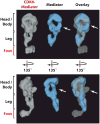The human Mediator complex: a versatile, genome-wide regulator of transcription
- PMID: 20299225
- PMCID: PMC2891401
- DOI: 10.1016/j.tibs.2010.02.004
The human Mediator complex: a versatile, genome-wide regulator of transcription
Abstract
The Mediator complex interacts extensively with the RNA polymerase II enzyme and regulates its ability to express protein-coding genes. The mechanisms by which Mediator regulates gene expression remain poorly understood, in part because the structure of Mediator and even its composition can change, depending upon the promoter context. Combined with the sheer size of the human Mediator complex (26 subunits, 1.2 MDa), this structural adaptability bestows seemingly unlimited regulatory potential within the complex. Recent efforts to understand Mediator structure and function have identified expanded roles that include control of both pre- and post-initiation events; it is also evident that Mediator performs both general and gene-specific roles to regulate gene expression.
Copyright 2010 Elsevier Ltd. All rights reserved.
Figures





Similar articles
-
The Mediator complex and transcription regulation.Crit Rev Biochem Mol Biol. 2013 Nov-Dec;48(6):575-608. doi: 10.3109/10409238.2013.840259. Epub 2013 Oct 3. Crit Rev Biochem Mol Biol. 2013. PMID: 24088064 Free PMC article. Review.
-
Interactions between subunits of the Mediator complex with gene-specific transcription factors.Semin Cell Dev Biol. 2011 Sep;22(7):759-68. doi: 10.1016/j.semcdb.2011.07.022. Epub 2011 Aug 4. Semin Cell Dev Biol. 2011. PMID: 21839847 Review.
-
The Mediator complex as a master regulator of transcription by RNA polymerase II.Nat Rev Mol Cell Biol. 2022 Nov;23(11):732-749. doi: 10.1038/s41580-022-00498-3. Epub 2022 Jun 20. Nat Rev Mol Cell Biol. 2022. PMID: 35725906 Free PMC article. Review.
-
The Plant Mediator Complex in the Initiation of Transcription by RNA Polymerase II.Annu Rev Plant Biol. 2024 Jul;75(1):211-237. doi: 10.1146/annurev-arplant-070623-114005. Epub 2024 Jul 2. Annu Rev Plant Biol. 2024. PMID: 38277699 Review.
-
The Mediator complex: a central integrator of transcription.Nat Rev Mol Cell Biol. 2015 Mar;16(3):155-66. doi: 10.1038/nrm3951. Epub 2015 Feb 18. Nat Rev Mol Cell Biol. 2015. PMID: 25693131 Free PMC article. Review.
Cited by
-
Core promoter-selective function of HMGA1 and Mediator in Initiator-dependent transcription.Genes Dev. 2011 Dec 1;25(23):2513-24. doi: 10.1101/gad.177360.111. Genes Dev. 2011. PMID: 22156211 Free PMC article.
-
Research Resource: Androgen Receptor Activity Is Regulated Through the Mobilization of Cell Surface Receptor Networks.Mol Endocrinol. 2015 Aug;29(8):1195-218. doi: 10.1210/me.2015-1021. Epub 2015 Jul 16. Mol Endocrinol. 2015. PMID: 26181434 Free PMC article.
-
Disruption of cardiac Med1 inhibits RNA polymerase II promoter occupancy and promotes chromatin remodeling.Am J Physiol Heart Circ Physiol. 2019 Feb 1;316(2):H314-H325. doi: 10.1152/ajpheart.00580.2018. Epub 2018 Nov 21. Am J Physiol Heart Circ Physiol. 2019. PMID: 30461303 Free PMC article.
-
Smad7:β-catenin complex regulates myogenic gene transcription.Cell Death Dis. 2019 May 16;10(6):387. doi: 10.1038/s41419-019-1615-0. Cell Death Dis. 2019. PMID: 31097718 Free PMC article.
-
Clinical, pathologic, cytogenetic, and molecular profiling in self-identified black women with uterine leiomyomata.Cancer Genet. 2018 Apr;222-223:1-8. doi: 10.1016/j.cancergen.2018.01.001. Epub 2018 Feb 19. Cancer Genet. 2018. PMID: 29666002 Free PMC article.
References
-
- Thompson CM, et al. A multisubunit complex associated with the RNA polymerase II CTD and TATA-binding protein in yeast. Cell. 1993;73:1361–1375. - PubMed
-
- Kim Y, et al. A multiprotein mediator of transcriptional activation and its interaction with the C-terminal repeat domain of RNA polymerase II. Cell. 1994;77:599–608. - PubMed
-
- Levine M, Tjian R. Transcription regulation and animal diversity. Nature. 2003;424:147–151. - PubMed
Publication types
MeSH terms
Substances
Grants and funding
LinkOut - more resources
Full Text Sources
Other Literature Sources

